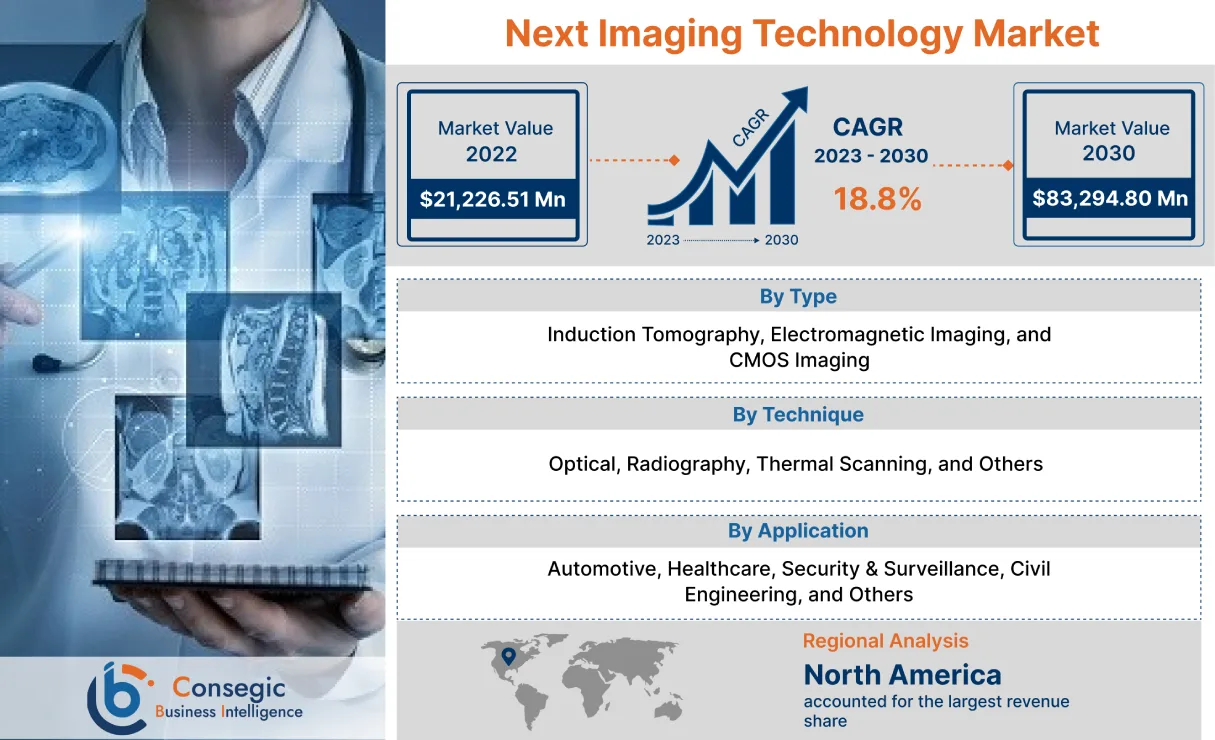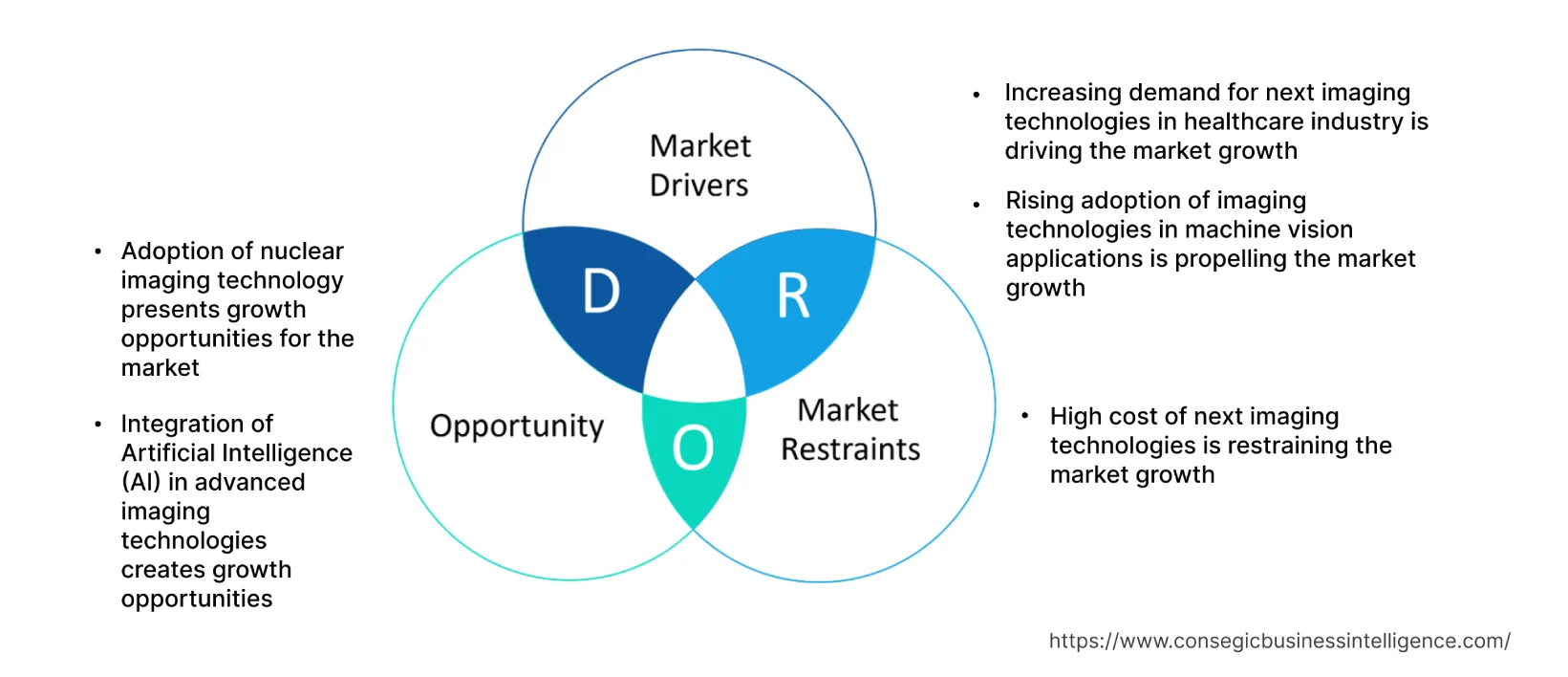Next Imaging Technology Market Introduction :
Next Imaging Technology Market size is estimated to reach over USD 83,294.80 Million by 2030 from a value of USD 21,226.51 Million in 2022, growing at a CAGR of 18.8% from 2023 to 2030.
Next Imaging Technology Market Definition & Overview :
Next imaging technology refers to the field of imaging that encompasses the development of new methods, techniques, and tools for capturing, processing, and displaying images. As per the analysis, the next imaging technology is the application of materials and methods to create, preserve, or duplicate images. Consequently, the next imaging technologies are aimed at improving the imaging capabilities in medical diagnostics, scientific research, industrial applications, and others.
Next Imaging Technology Market Insights :
Next Imaging Technology Market Dynamics - (DRO) :
Key Drivers :
Increasing demand for next imaging technologies in healthcare industry is driving the market growth
The increasing demand for imaging technologies in medical diagnostics and treatment planning is driving the growth of the market. Medical imaging is the process of creating visual representations of the interior parts of the body for clinical analysis as well as visual representation of the function of organs or tissues. Next imaging technologies such as Magnetic Resonance Imaging (MRI), Computed Tomography (CT) enable healthcare professionals to visualize and detect abnormalities in the body for detection of diseases. For instance, in June 2023, GE HealthCare launched deep learning-based technology called Sonic DL that captures high-quality Magnetic Resonance (MR) images for cardiac imaging applications. Thus, the application of next imaging technologies for accurate and early detection of diseases is accelerating the demand of the market.
Rising adoption of imaging technologies in machine vision applications is propelling the market
The increasing adoption of advanced imaging technologies for automated machine vision systems is propelling the expansion of the market. The utilization of image sensors with enhanced sensitivity and dynamic range allows for detailed and accurate inspection of industrial processes. Moreover, the incorporation of 3D imaging technologies including depth sensing is further driving the market. For instance, in April 2023, Newsight Imaging launched a new imaging sensor called Multi-Triangulation (MT) LiDAR 3.1 featuring 480 depth points for accurate 3D mapping in robotics and industrial automation processes. Consequently, the advancements in imaging technologies for inspection of different objects and processes is proliferating the next imaging technology market trend.
Key Restraints :
High cost of next imaging technologies is restraining the market
Next imaging technologies involves advanced hardware components, specialized sensors, and software for detailed analysis and inspection. The incorporation of such components adds up to the overall cost of next imaging technologies. Moreover, the integration of next imaging technologies into existing systems is quite complex that further increases the cost of implementation of next imaging technologies. Therefore, the high cost of implementing next generation imaging technologies in hindering the expansion of the next imaging technology market.
Future Opportunities :
Adoption of nuclear imaging technology presents growth opportunities for the market
The adoption of nuclear imaging technologies including Positron Emission Tomography (PET) and Single-Photon Emission Computed Tomography (SPECT) in medical diagnostics is expected to present potential opportunities for the next imaging technology market growth during the forecast period. The technology involves ingestion of a radioactive substance for visualization and assessment of processes including metabolism and organ functional at the molecular level. Consequently, the radiations are detected by a computer for the diagnosis of potential diseases. For instance, in December 2020, U.S. Food and Drug Administration approved first drug called Gallium 68 PSMA-11 for PET imaging in men with prostate cancer. Therefore, the application of nuclear imaging technologies in medical diagnosis is expected to propel the next imaging technology market during the forecast period.
Integration of Artificial Intelligence (AI) in advanced imaging technologies creates growth opportunities
The integration of advanced technologies including Artificial Intelligence (AI) in these imaging technologies is expected to create next imaging technology market opportunities during the forecast period. AI is expected to improve accuracy and sensitivity in the identification of abnormalities in the human body. Moreover, AI is expected to accurately detect colorectal cancer by analyzing tissue scans. For instance, in November 2021, Koninklijke Philips N.V. launched new AI-enabled MR portfolio of smart diagnostic systems designed to speed up MR exams, optimize diagnostic quality, and help ensure the efficiency and sustainability of radiology operations. Therefore, the adoption of advanced technologies is expected to revolutionize the healthcare sector, thus propelling the next imaging technology market during the forecast period.
Next Imaging Technology Market Report Insights :
| Report Attributes | Report Details |
| Study Timeline | 2017-2030 |
| Market Size in 2030 | USD 83,294.80 Million |
| CAGR (2023-2030) | 18.8% |
| Based on the Type | Induction Tomography, Electromagnetic Imaging, and CMOS Imaging |
| Based on the Technique | Optical, Radiography, Thermal Scanning, and Others |
| Based on the Application | Automotive, Healthcare, Security & Surveillance, Civil Engineering, and Others |
| Based on the Region | North America, Europe, Asia-Pacific, Latin America, and Middle East & Africa |
| Key Players | Barco, Flir Systems, Galaxy Core, Imaging Technology Solutions, Karl Storz, Olympus., Qualcomm Technologies, Sk Hynix, Sony, Toshiba Corporation, GE HealthCare |
Next Imaging Technology Market Segmental Analysis :
Based on the Type :
Based on the type, the market is trifurcated into induction tomography, electromagnetic imaging, and CMOS imaging. The electromagnetic imaging segment accounted for the largest next imaging technology market share in the year 2022. Electromagnetic imaging is a functional imaging technique that uses electromagnetic fields to obtain an image of the interior of an object. As a result, the technique is deployed for mapping of geological structures such as earth, soil, and water. Moreover, electromagnetic imaging is used for non-destructive testing for the detection of defects and quality of a wide variety of materials. Consequently, the ability of electromagnetic technique to produce high-resolution images is accelerating the development of the market.
The CMOS imaging segment is expected to emerge as the fastest-growing segment during the forecast period in the next imaging technology market. The increasing adoption of CMOS imaging technology in consumer electronics, automotive, and machine vision systems is propelling the market. CMOS imaging technologies is utilized in consumer electronics devices for the production of high-quality images. For instance, in December 2022, Canon Singapore Pte. Ltd. launched four new CMOS sensors called LI5030SAI, LI5030SAN, LI5030SAM, and LI5030SAC featuring pixel count of 19 MP to capture high-speed videos in industrial monitoring applications. Moreover, the application of CMOS imaging technology in ADAS systems to enhance safety on roads is expected to drive the market trend.
Based on the Technique :
Based on the technique, the market is separated into optical, radiography, thermal scanning, and others. The optical imaging segment accounted for the largest revenue share of 39.4% in the year 2022. Optical imaging technology utilizes visible light to capture and analyze images. The technology is widely utilized in scientific research applications including microscopy. Optical imaging technology plays a crucial role in analyzing microscopic structures and biological samples. Moreover, the application of optical imaging technology in consumer electronics devices such as smartphones and digital cameras is accelerating the market.
The radiography segment is projected to witness the fastest CAGR during the forecast period. Based on the next imaging technology market analysis, the increasing demand for accurate diagnostic imaging in medical sector is driving the expansion of the market. Radiographic techniques including X-ray imaging, CT scan, and MRI are extensively used for visualizing internal structures of the body. For instance, in May 2023, Koninklijke Philips N.V. launched AI-powered CT system called Philips CT 3500 for routine radiology and high-volume screening programs. Moreover, as per the analysis, the adoption of advanced imaging technologies to detect abnormal tissue development in the body is propelling the next imaging technology market demand and trend.
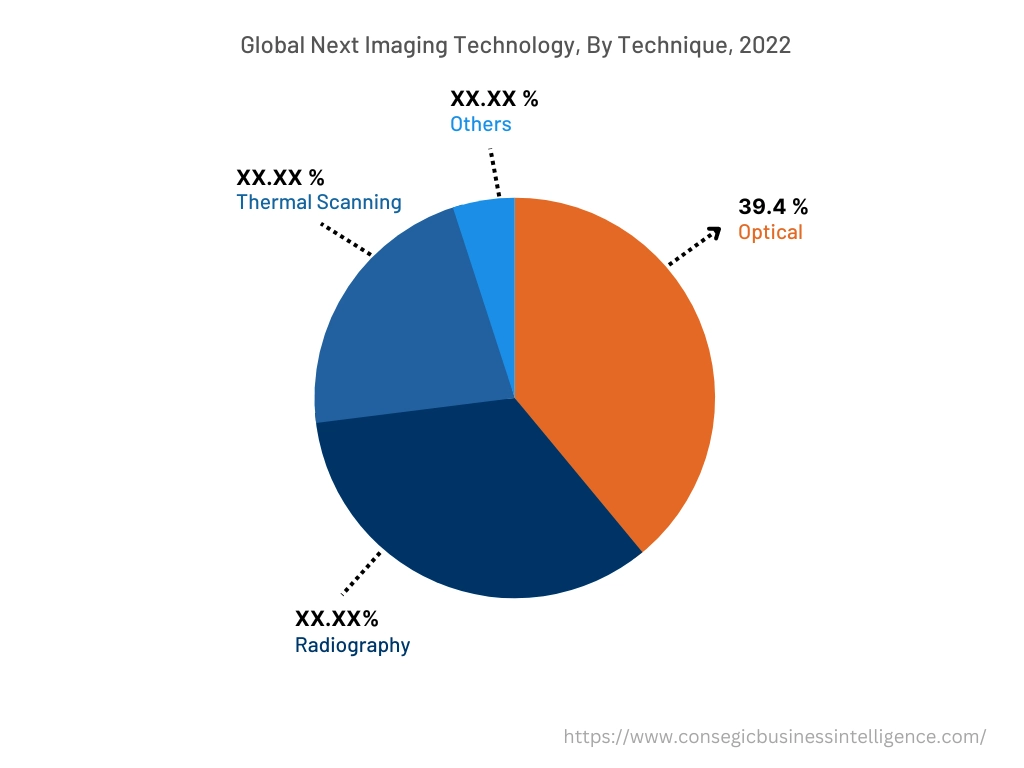
Based on the Application :
Based on the application, the market is trifurcated into automotive, healthcare, security & surveillance, civil engineering, and others. The healthcare segment accounted for the largest revenue share in the year 2022 in the next imaging technology market. Next imaging technologies play a vital role in healthcare diagnostics, monitoring, and treatment planning. Imaging technologies including endoscopy, laparoscopy, and catheter-based imaging are used during surgical procedures that provide vision inside a patient body with the help of a camera. For instance, in September 2022, Olympus launched surgical visualization platform called VISERA ELITE III for endoscopic procedures across multiple medical disciplines. Furthermore, the application of next imaging technology for routine radiology testing is driving the expansion of the market.
The security & surveillance segment is expected to witness the fastest CAGR during the forecast period. Advanced imaging technologies are used in high-resolution security and thermal cameras for video surveillance in public places including airports, transportation hubs, and others. Moreover, the application of security cameras for inspection and monitoring of critical infrastructure in industries is anticipated to drive the next imaging technology industry and trend during the forecast period.
Based on the Region :
The regional segment includes North America, Europe, Asia Pacific, Middle East and Africa, and Latin America.
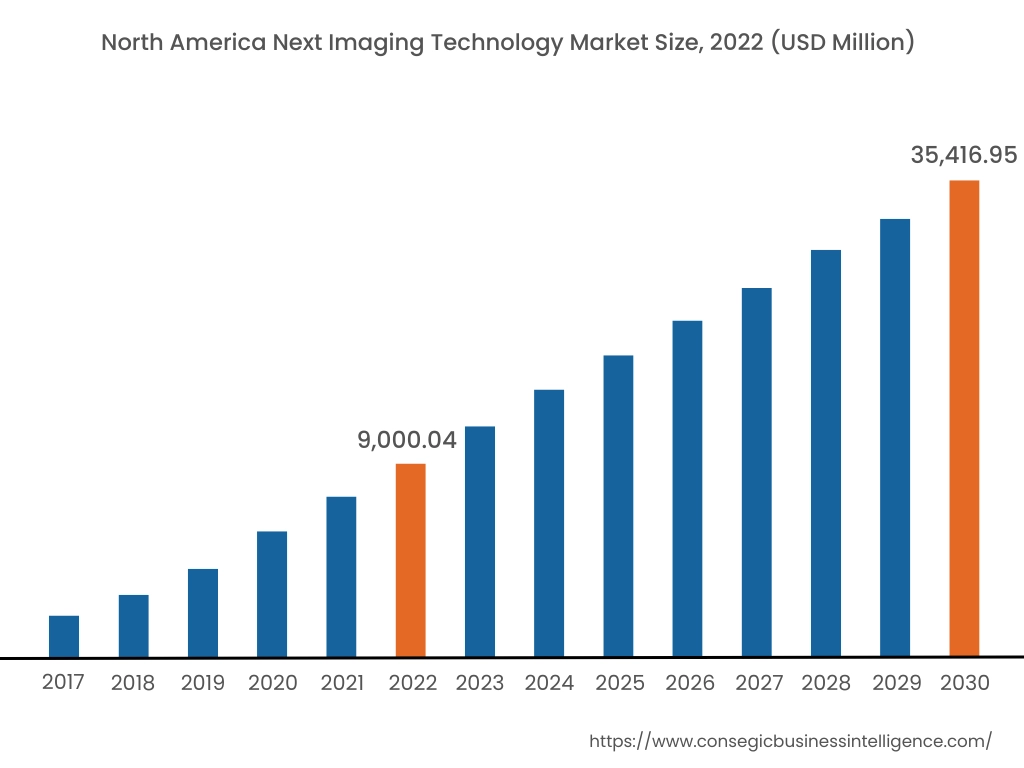
North America accounted for the largest revenue share of USD 9,000.04 million in 2022 and is expected to reach USD 35,416.95 million in 2030, registering a CAGR of 18.9% during the forecast period. Additionally, in the region, United States accounted for the largest revenue share of 55.70% in the year 2022. The well-developed healthcare industry in North America is driving the next imaging technology market. Hospitals and diagnostic labs are deploying advanced imaging technologies including molecular imaging and functional imaging for conducting surgical procedures. Moreover, integration of advanced technologies including AI in next imaging technologies allows for more detailed and accurate visualization of objects and systems. Thus, as per the analysis, key players in the region are deploying next imaging technologies for automation in industries and machine vision applications. For instance, in February 2020, Next Imaging expanded the platform of Next Imaging in North America by acquiring 1st Vision for the production of machine vision systems by increasing manufacturing efficiency and scrap reduction.
Asia-Pacific region is anticipated to register the fastest CAGR growth of 19.1% during the forecast period. The large manufacturing base in countries including China, Japan, and India is driving the growth of the market. Manufacturers are taking several initiatives in producing cameras with advanced imaging technologies. Moreover, the increasing adoption of advanced imaging technologies for security & surveillance of critical infrastructure in public spaces is driving the development of the market. Additionally, based on the analysis, the application and trend of next imaging technologies in automotive industry for ADAS systems is expected to drive the expansion of the regional next imaging technology market trend during the forecast period.
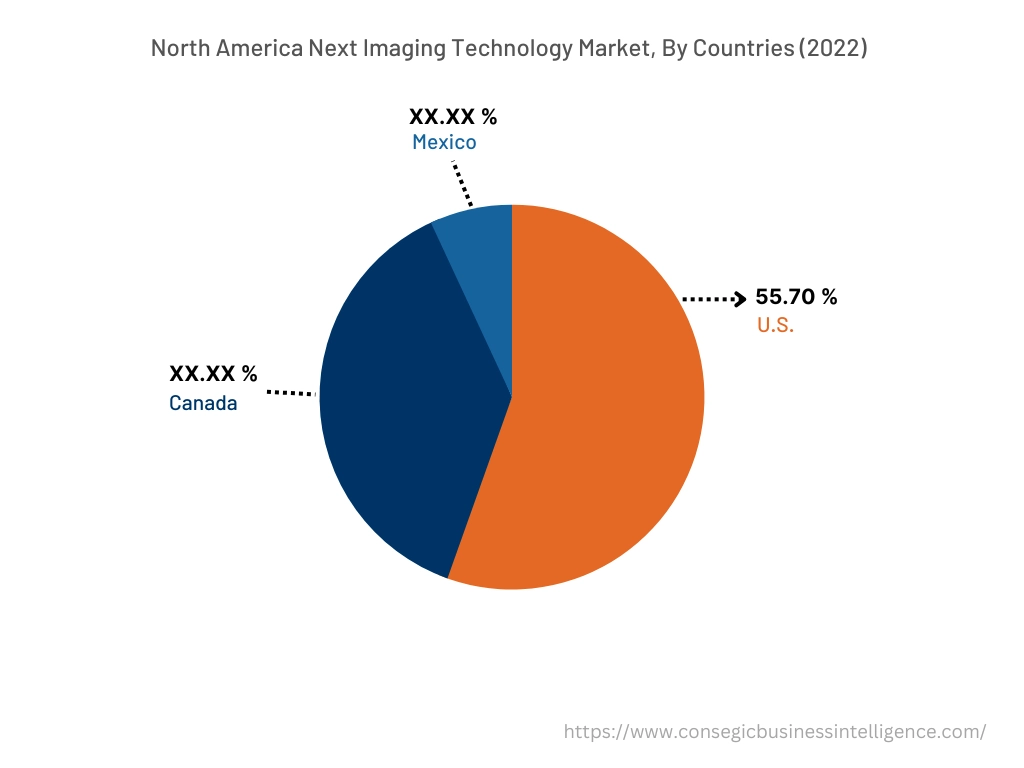
Top Key Players & Market Share Insights :
The next imaging technology market is highly competitive with major players providing advanced next imaging technologies for different applications. Key players are adopting several strategies in product innovation, research, and development (R&D), and various business strategies, and application launches have accelerated the trend of the next imaging technology market. Key players in the market include-
- Barco
- Flir Systems
- Sk Hynix
- Sony
- Toshiba Corporation
- GE HealthCare
- Galaxy Core
- Imaging Technology Solutions
- Karl Storz
- Olympus
- Qualcomm Technologies
Recent Industry Developments :
- In August 2021, Abbott received approval from U.S. Food and Drug Administration (FDA) for its optical coherence tomography (OCT) imaging platform that provides comprehensive view of coronary blood flow and blockages in human body.
- In March 2022, Siemens Healthcare Private Limited launched MAGNETOM Free Star and NAEOTOM Alpha featuring DryCool technology to produce high-resolution images of organs inside the human body.
Key Questions Answered in the Report
What is next imaging technology? +
Next imaging technology refers to the advanced technologies that creates and analyses images for a wide-variety of applications.
What specific segmentation details are covered in the next imaging technology report, and how is the dominating segment impacting the market growth? +
The report consists of segments including type, technique, and application. Each segment has key dominating sub-segment being driven by the industry trends and market dynamics. For instance, by technique has witnessed optical imaging technology as the dominating segment in the year 2022, due to its adoption in scientific research applications including microscopy.
What specific segmentation details are covered in the next imaging technology market report, and how is the fastest segment anticipated to impact the market growth? +
The report consists of segments including type, technology, and application. Each segment is projected to have the fastest-growing sub-segment being fueled by industry trends and drivers. For instance, by application segment has witnessed security & surveillance as the fastest-growing segment during the forecast period due to the application of advanced imaging technologies for the inspection of critical infrastructure.
Which region/country is anticipated to witness the highest CAGR during the forecast period, 2023-2030? +
Asia-Pacific is expected to register fastest CAGR growth during the forecast period due to the increasing adoption of next imaging technologies in automotive industry.
